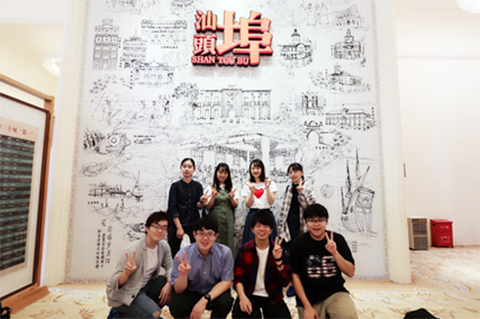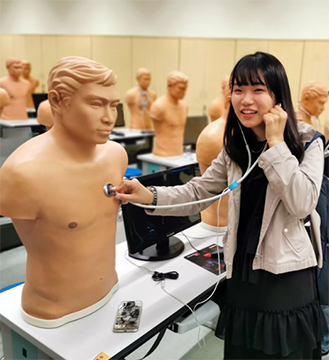International and Domestic exchange
Erina Hiraishi (2nd year student)
After studying abroad at Shantou University
After reading the impressions of my seniors who studied abroad at Shantou University, I learned that medical care in China is very different from Japan, such as people in poor areas who want to receive medical care but cannot, and hospital rooms with so many beds that they don't fit all, and I wanted to see it with my own eyes and hear from patients. Also, although there is still a lot I don't know about medical care in Japan, I thought that seeing medical care around the world at an early stage would have a big impact on my future learning, so I wanted to participate in this program.
During my study abroad, all the teachers I met were very kind and enthusiastic, and they welcomed us warmly from start to finish, from the time we arrived at the airport until we returned home.
At the welcome party on the first day, we heard about the Li Ka Shing Foundation. The Li Ka Shing Foundation's medical support focuses on three areas: 1. volunteering for the poor, 2. free hospice care, and 3. support for cleft lip and palate patients. In Japan, there are no large volunteer organizations that include universities and university hospitals like the Li Ka Shing Foundation, only individual volunteers and small organizations. I learned a lot from being able to participate in the activities of such a large volunteer organization.
When I went to a village with many poor people for volunteer work, I took a bus for about an hour and a half with students from Shantou University. There were four booths set up in the gymnasium of an elementary school, one for blood pressure measurement, one for vision test, one for physical examination, and one for interview with a doctor. Students were able to help out at the booths other than the one for interview with a doctor, and I also had the opportunity to measure the blood pressure of patients. Unlike the electronic blood pressure monitors commonly seen in Japan, this one used a mercury column. I had used it once in a Physiology training class, but I was nervous when I actually used it on a patient. I'm glad I learned how to use it. All the Chinese students were accustomed to volunteering, and they were able to use the mercury column blood pressure monitor well, and they were very smooth in dealing with patients. The local students who worked efficiently with the doctors were smiling and talking to the residents. I thought this volunteer work was also important for the local medical students to become aware that they would become doctors in the future. It was a wonderful experience for me as well.
During the hospice visit, I accompanied a patient with terminal lung cancer on a home visit. At the first consultation, the doctor recommended that the patient apply for poverty insurance. China's public medical insurance system is classified according to whether the patient lives in a city or a rural area and whether they are employed or not, and even if they apply for insurance, it is difficult to get it because there are many applicants and there are restrictions. What I noticed most about the hospice visit was that the interview time was very long, more than an hour for just one patient. Since there are no electronic medical records or sufficient medical equipment in home visits, the interview is very important in deciding future treatment. The doctor looked the patient and his family in the eye and spoke to them until the patient was reassured. The doctor occasionally explained the current treatment and future medical policy to us in English.
In the home visits of patients who live alone in poor villages and cannot leave their homes due to illness, in addition to refilling their medicines, the doctors provided them with oil and rice. The doctors spoke to the patients very kindly and made sure they were taking the prescribed medicine properly. The patients willingly cooperated with us students to observe the examinations as a learning experience.
On the tour of the medical building at Shantou University, we first went to the Human Laboratory of Anatomy Hall. There were models with actual human organs, muscles, and blood vessels, and I heard that students use them to study. On the top floor is the Clinical Skills Center, which includes the reception, examination rooms, patient rooms, operating rooms, ICU, and delivery rooms, and is actually used in OSCEs. In the ICU, we used a patient model to check the electrocardiogram, check pupil constriction, and take the pulse. In another room, there was a model that allowed us to hear normal heart sounds and arrhythmias with a stethoscope, and we experienced examining a patient using a stethoscope. The facilities were fully equipped to allow students to study in an environment as close as possible to the actual medical field, and I thought it would be great if we could learn like this at Japanese universities. In the examination room, students were preparing for the OSCE by playing the role of patients and doctors, and in the discussion room, students gathered to discuss, and I felt the high level of awareness of the local students. Not only at universities, but also at the Shantou University Oral and Maxillofacial Surgery Center, which we visited, there was a simulation room, and at the Ophthalmology Center, they practiced surgery using pig eyeballs to hone their skills.
In addition, Shantou University Hospital has a department of Chinese medicine in addition to the department of internal medicine, which made me realize once again how advanced Chinese medicine is in China. At the pharmacy, Chinese medicine is prepared right behind the reception desk, and there were countless types of Chinese medicine lined up on the shelves. I was very surprised to learn that centipedes, scorpions, and cicada shells are also used in Chinese medicine. When I walked around the area around the hotel, I also came across a pharmacy that sold Chinese medicine by weight, separate from the drugstore. Many people request Chinese medicine when getting a prescription, and I learned that Chinese medicine is widely used in China.
While high-rise apartment buildings stand side by side in urban areas, in a market on the outskirts of town, flies were flying around raw meat and people were filleting and selling fish on the street. I was very surprised to see people putting the fish they bought directly into plastic carrier bags. With the huge gap between rich and poor, it is not easy to improve the quality of life, but I felt that hygiene was an issue.
The medical environment in China is better than in Japan, and there are many hospitals with cutting-edge technology, but I felt that Japan is more advanced in terms of medical supply. Through my one-week study abroad, I was able to experience the depth of medicine, which goes beyond just acquiring knowledge and skills. I will use this experience in my future studies.
Finally, I would like to express my sincere gratitude to the professors who gave me the opportunity to study abroad and to the professors at Shantou University who supported me there. Now that I have returned to Japan, I feel that I have had an invaluable experience. Thank you very much.

